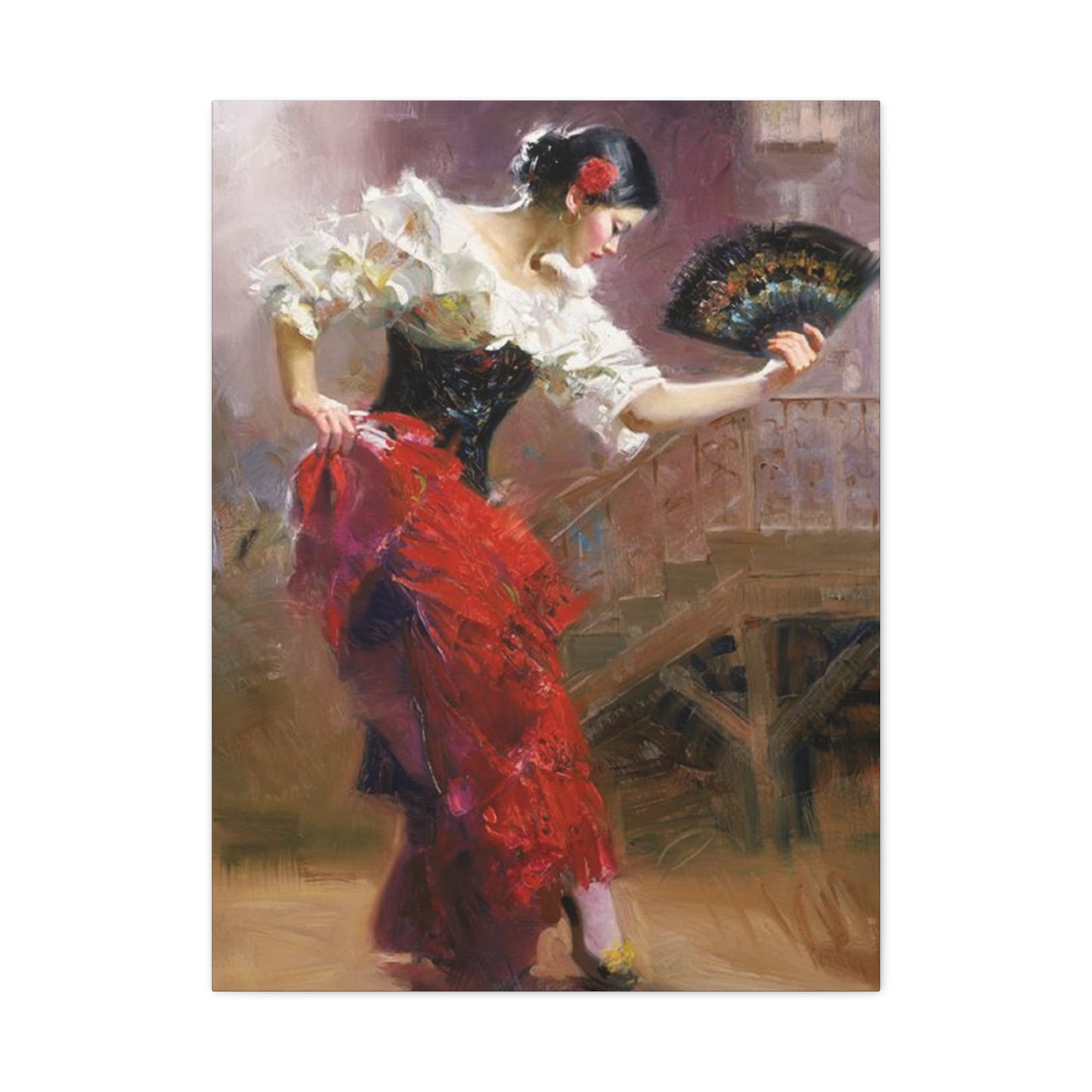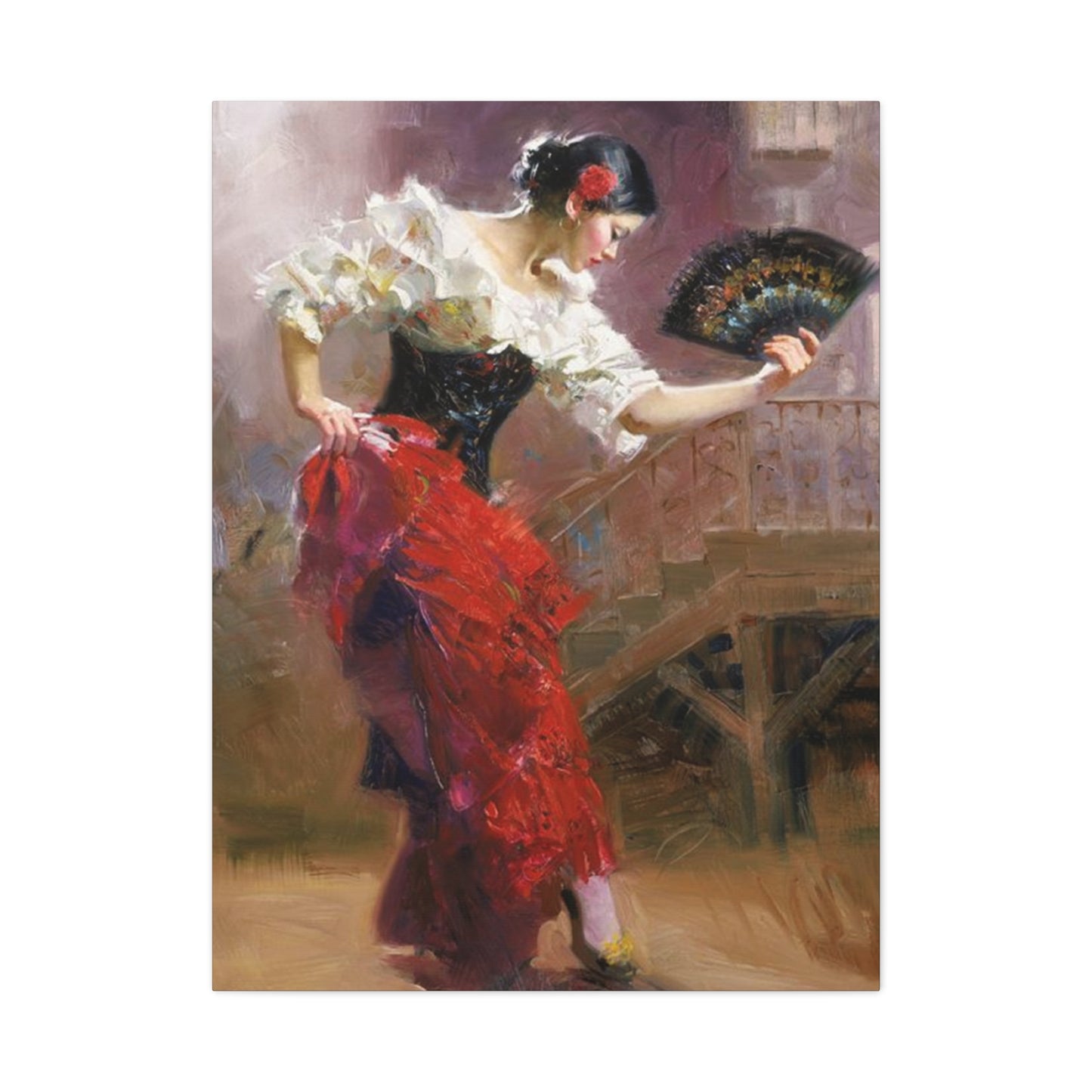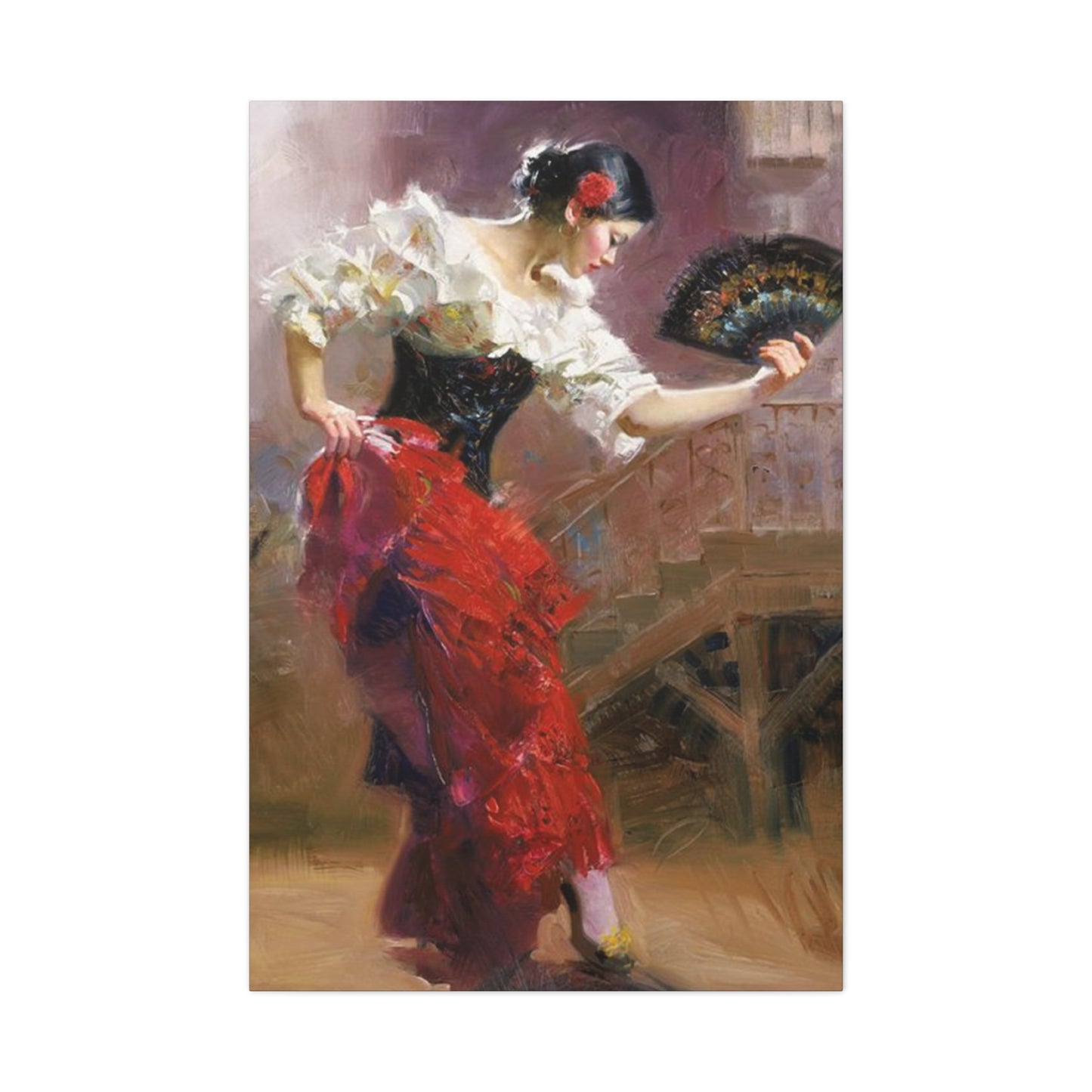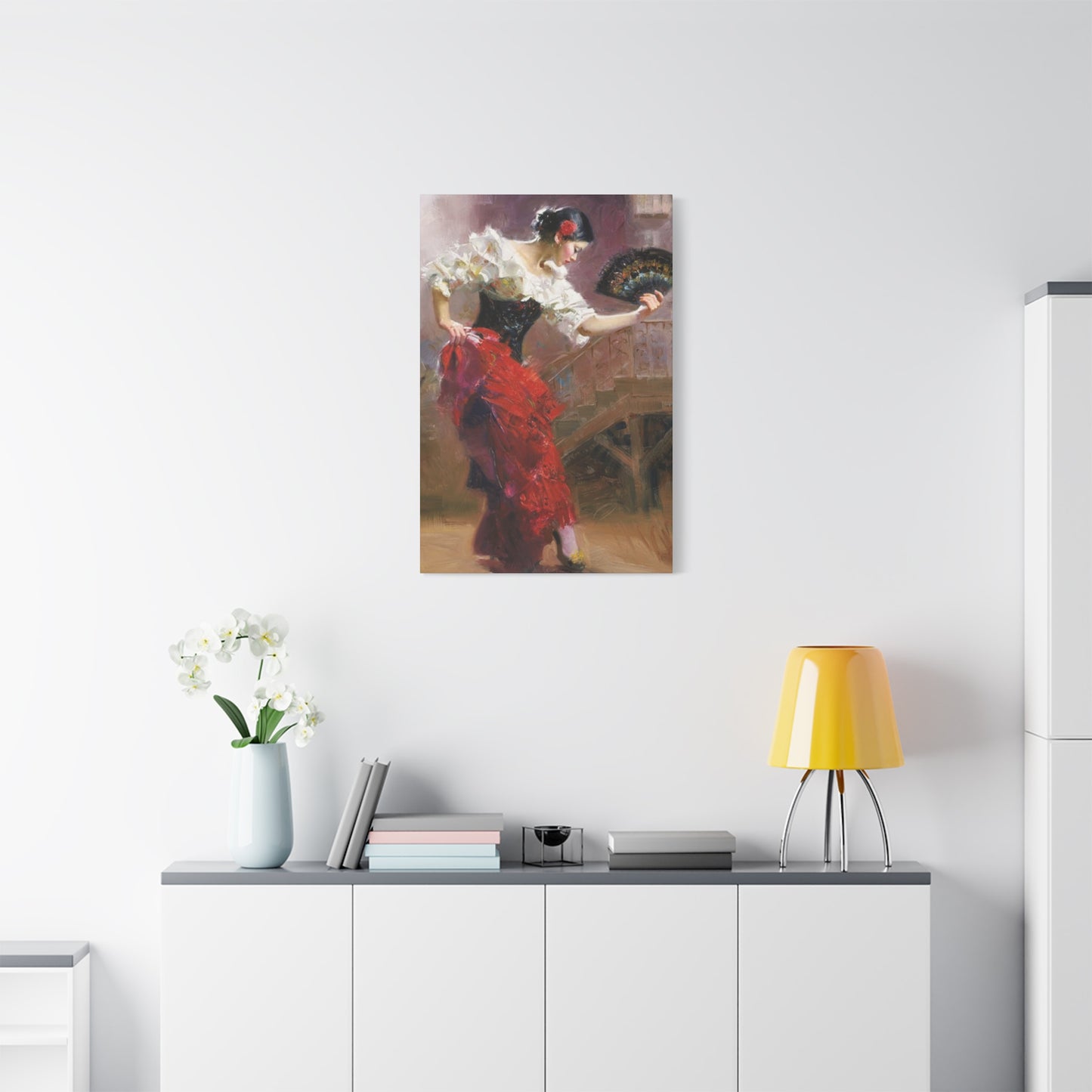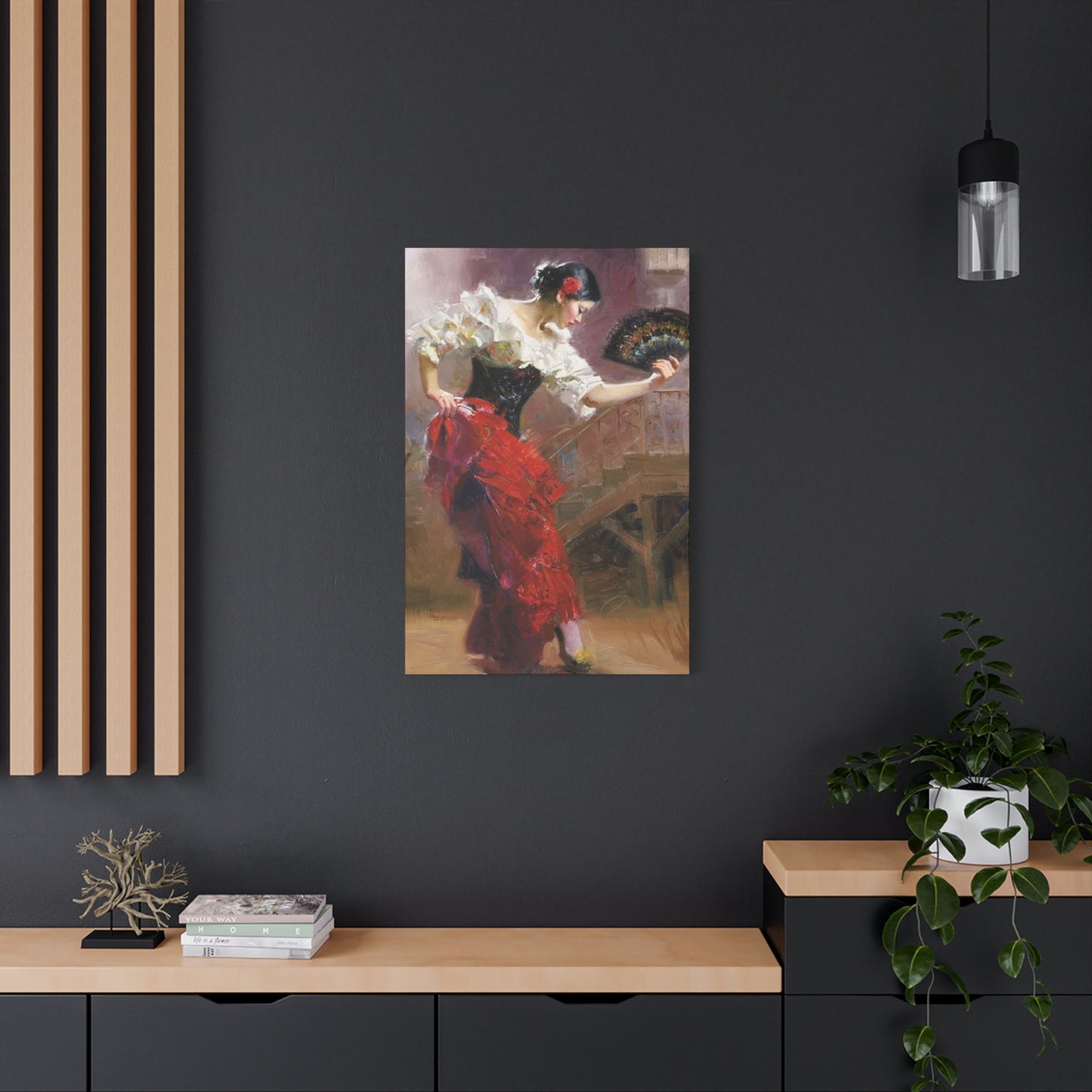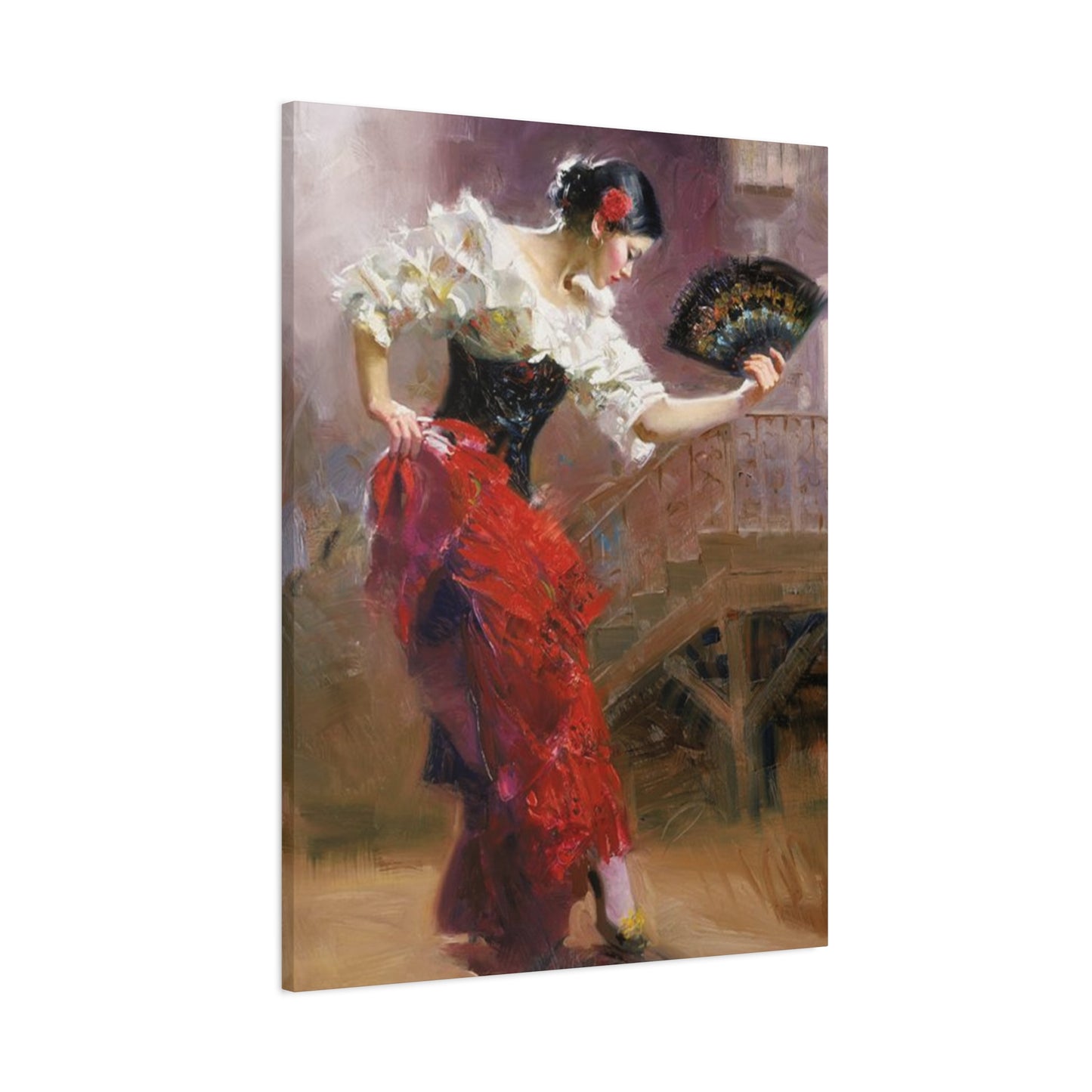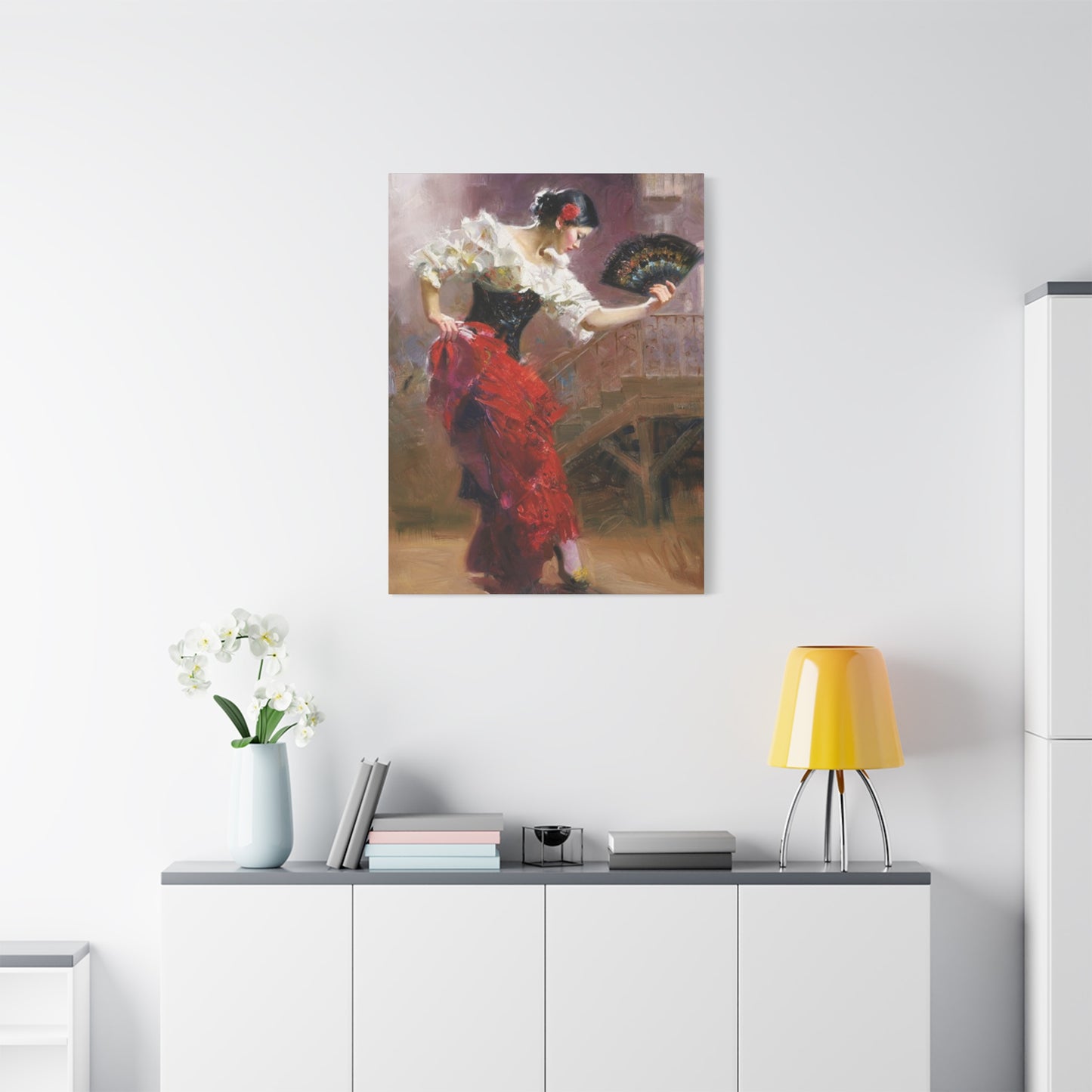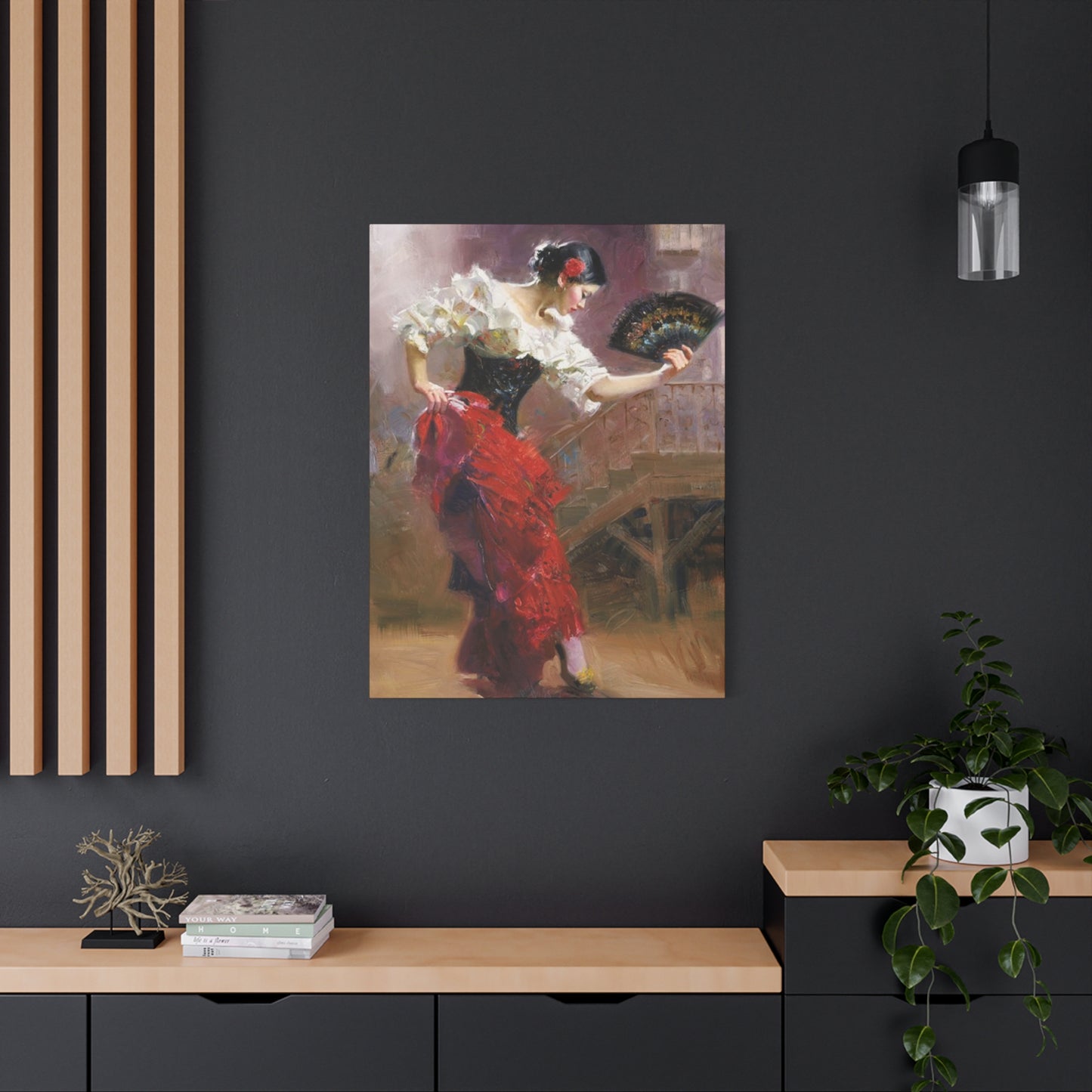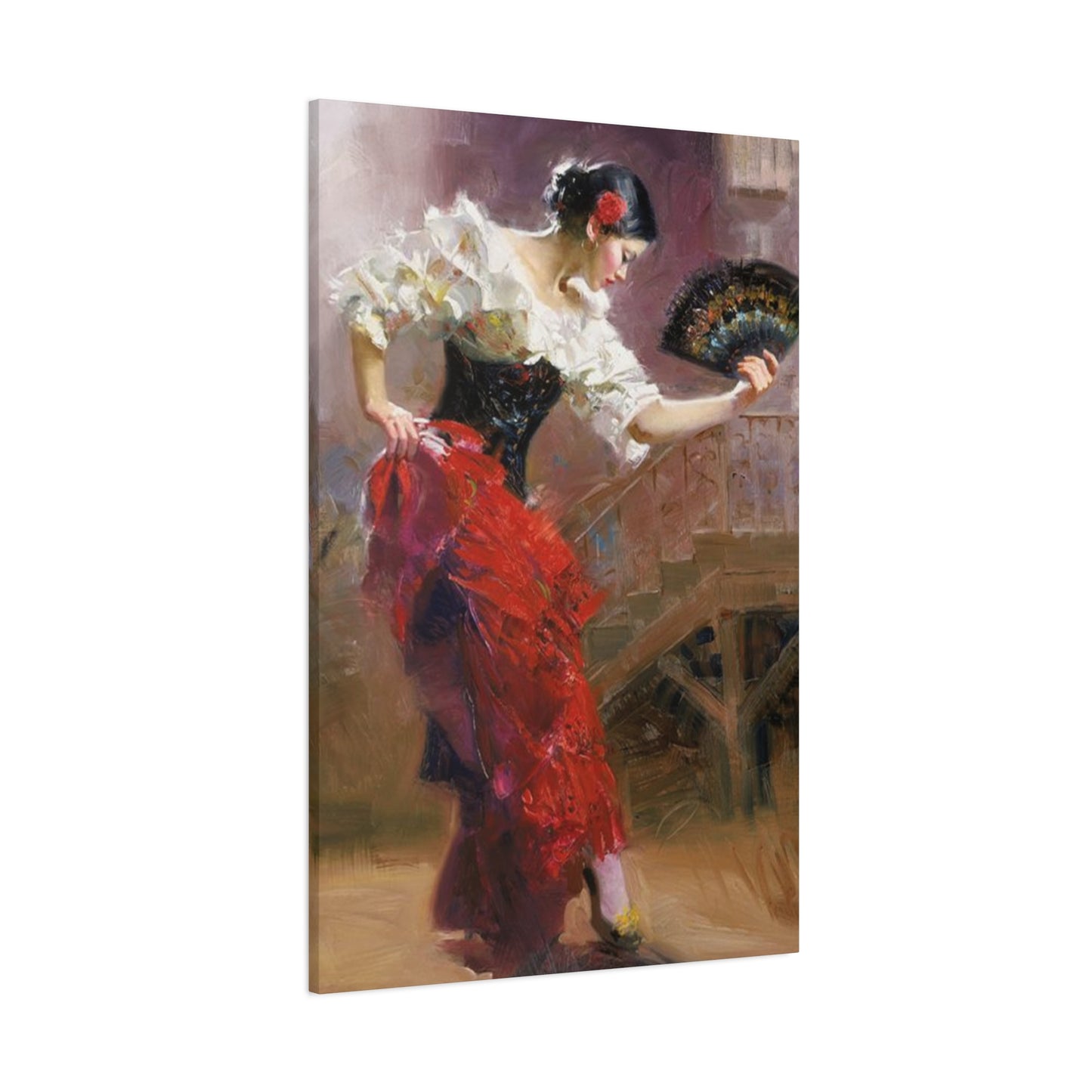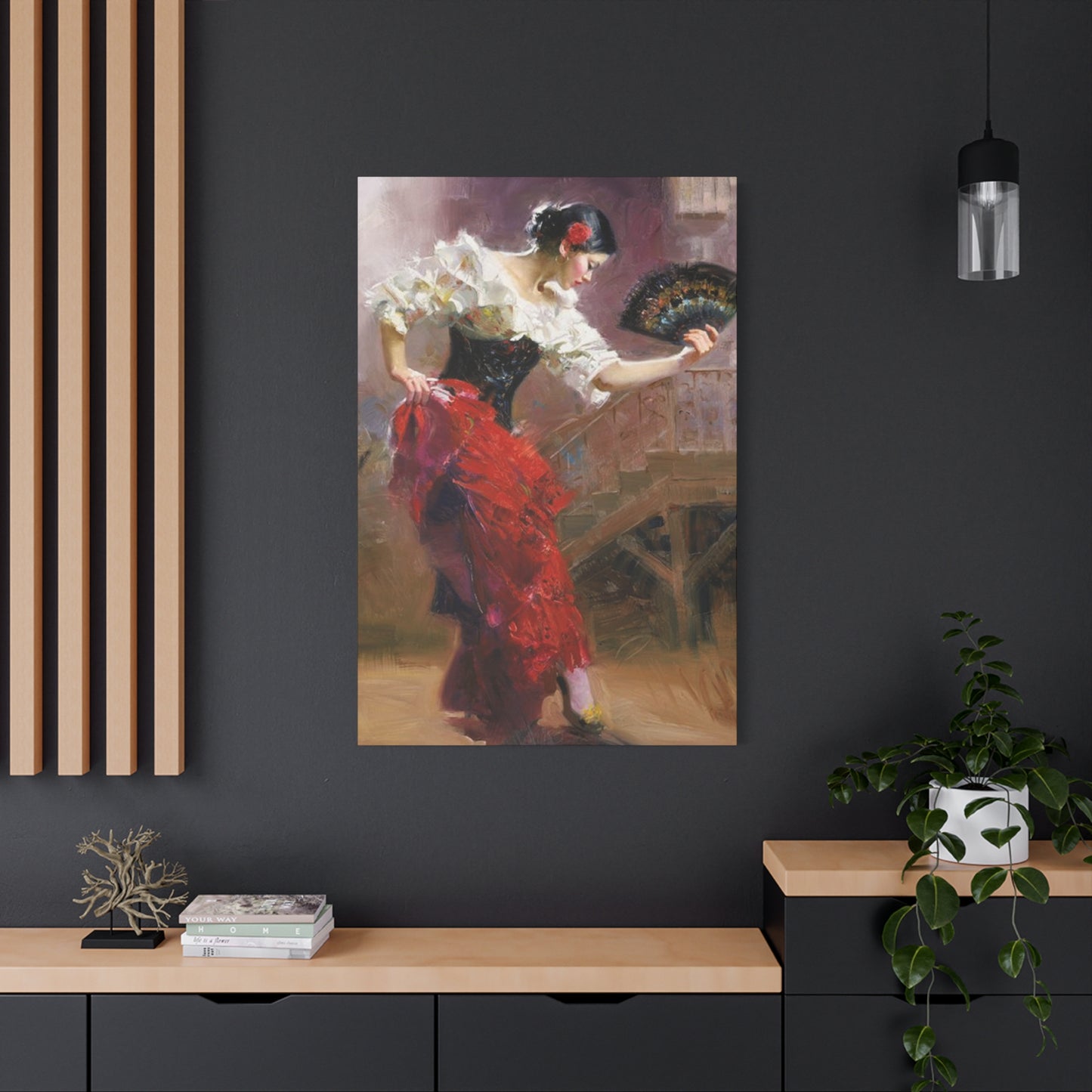Passion of Movement: Exploring Spain’s Traditional Dancer Paintings in Wall Art
Spanish flamenco dancer paintings have captivated art enthusiasts and interior designers for generations, representing more than mere decorative pieces. These stunning canvas prints embody the passionate spirit, cultural richness, and vibrant energy of Spain's most iconic traditional art form. The visual representation of flamenco dancers captured in various artistic styles has become increasingly popular in contemporary home decor, offering homeowners an opportunity to infuse their living spaces with cultural sophistication and dynamic visual interest.
The appeal of Spanish dancer wall art extends beyond aesthetic appreciation. These canvas prints serve as conversation starters, cultural bridges, and focal points that transform ordinary rooms into extraordinary spaces filled with character and personality. Whether rendered in bold, modern abstract styles or classical realistic approaches, flamenco dancer paintings bring an unmistakable sense of movement, passion, and artistic expression to any environment where they are displayed.
Interior design professionals consistently recommend Spanish dancer canvas prints for homeowners seeking to add dramatic flair to their spaces without overwhelming existing decor themes. The versatility of these artworks allows them to complement various interior styles, from rustic Mediterranean and contemporary minimalist to eclectic bohemian and traditional European designs. The flowing lines of a dancer's dress, the dramatic positioning of arms and hands, and the intense emotional expression captured in these paintings create visual narratives that resonate with viewers on multiple levels.
Canvas prints featuring traditional Spanish dancers have experienced remarkable growth in popularity across global markets. This surge reflects broader trends in home decoration that favor culturally significant artwork over generic mass-produced pieces. Homeowners increasingly seek meaningful decor that reflects their personal interests, travel experiences, or appreciation for world cultures. Spanish dancer paintings perfectly fulfill this desire while simultaneously providing visually striking focal points that elevate the overall ambiance of living rooms, dining areas, bedrooms, offices, and entertainment spaces.
The technical quality of modern canvas printing technology has revolutionized how Spanish dancer artwork reaches consumers. High-resolution printing methods, fade-resistant inks, and gallery-quality canvas materials ensure that these reproductions maintain their vibrancy and visual impact for years. This technological advancement has made it possible for art lovers to enjoy museum-quality representations of flamenco dancers at accessible price points, democratizing access to culturally significant artwork that was once available only through expensive original paintings or limited edition prints.
Significance of Flamenco Dance in Spanish Culture
Flamenco dance represents one of Spain's most recognized cultural treasures, with roots stretching back centuries through Andalusian history. This passionate art form emerged from the cultural melting pot of southern Spain, where Romani, Moorish, Jewish, and indigenous Andalusian influences blended to create something entirely unique. The dance style embodies raw emotion, technical precision, and improvisational creativity, making it an endlessly fascinating subject for artists throughout history.
The historical development of flamenco as both a performance art and a visual subject for painters reveals much about Spanish cultural identity and artistic evolution. During the Romantic period of the 19th century, European artists became increasingly fascinated with Spanish culture, viewing it as exotic, passionate, and dramatically different from the reserved cultures of northern Europe. This fascination led to countless artistic representations of Spanish dancers, musicians, and cultural scenes that helped shape international perceptions of Spanish identity.
Traditional flamenco dance incorporates complex footwork, intricate hand movements, dramatic body positioning, and intense facial expressions that convey deep emotional states ranging from profound sorrow to explosive joy. These dynamic qualities make flamenco dancers particularly compelling subjects for visual artists who seek to capture movement, emotion, and cultural authenticity in static images. The challenge of representing such kinetic energy and emotional intensity on canvas has inspired generations of artists to develop innovative techniques and approaches to painting human figures in motion.
Throughout Spanish art history, renowned painters have turned their attention to flamenco dancers as subjects worthy of serious artistic treatment. These artists recognized that capturing the essence of flamenco required more than technical skill in rendering human anatomy or clothing details. It demanded an understanding of the dance's emotional core, its cultural significance, and the subtle ways that body language communicates feeling and story. The best paintings of Spanish dancers transcend mere representation to become visual poetry that speaks to universal human experiences of passion, struggle, celebration, and artistic expression.
The preservation of flamenco cultural heritage through visual art has played an important role in maintaining connections to traditional Spanish culture even as modern society evolves. Canvas prints featuring traditional Spanish dancers serve as cultural ambassadors, introducing new generations and international audiences to this magnificent art form. These reproductions help keep flamenco alive in the public consciousness, inspiring curiosity about its history, techniques, and contemporary expressions while providing accessible entry points for those interested in exploring Spanish cultural traditions more deeply.
Artistic Styles and Interpretations in Spanish Dancer Canvas Prints
Spanish dancer paintings encompass an remarkable range of artistic styles, each offering distinct aesthetic qualities and emotional resonances. Realistic representations capture the precise details of traditional flamenco costumes, including the intricate patterns of ruffled dresses, the delicate lacework of shawls, and the polished surfaces of dance shoes. These detailed paintings appeal to viewers who appreciate technical skill and authentic cultural representation, providing windows into the actual appearance and atmosphere of flamenco performances.
Impressionistic interpretations of Spanish dancers focus on capturing the emotional essence and sense of movement rather than precise physical details. These paintings often feature looser brushwork, vibrant color palettes, and emphasis on light and shadow that convey the energy and passion of flamenco without being constrained by photographic accuracy. The impressionistic approach allows artists to express the subjective experience of watching flamenco, translating the music's rhythm, the dancer's intensity, and the audience's emotional response into visual language that resonates on an instinctive level.
Abstract and modern interpretations of Spanish dancer themes push artistic boundaries even further, reducing the figure to essential shapes, lines, and colors that suggest rather than explicitly depict the dance. These contemporary canvas prints appeal to collectors and decorators who appreciate bold, avant-garde aesthetic approaches that challenge conventional representation while still maintaining recognizable connections to their flamenco inspiration. Abstract Spanish dancer paintings work particularly well in modern and minimalist interior designs where they provide cultural depth without visual clutter or excessive detail.
Expressionistic Spanish dancer paintings emphasize emotional intensity through exaggerated colors, distorted proportions, and dramatic compositions that convey psychological and spiritual dimensions of the dance. These works often feature bold contrasts between light and dark, intense color saturation, and dynamic compositional arrangements that create visual tension and energy. Expressionistic approaches resonate with viewers who appreciate art that communicates powerful feelings and creates strong emotional responses, making these canvas prints particularly effective in spaces designed for contemplation, conversation, or creative work.
Traditional folk art styles offer another fascinating approach to Spanish dancer imagery, incorporating decorative patterns, simplified forms, and bright color schemes characteristic of regional Spanish artistic traditions. These folk-inspired canvas prints bring a sense of authenticity and cultural rootedness that appeals to collectors interested in traditional crafts and cultural preservation. The naive or folk art aesthetic creates approachable, cheerful artwork that works beautifully in casual, family-oriented spaces where the goal is creating warmth and welcoming atmosphere rather than formal sophistication.
Its Impact in Flamenco Dancer Artwork
Color selection plays a crucial role in determining the emotional impact and decorative effectiveness of Spanish dancer canvas prints. Traditional flamenco imagery often features bold primary colors, particularly reds, blacks, and whites, which carry deep cultural significance within Spanish tradition. Red symbolizes passion, blood, and life force, appearing prominently in dancer's dresses and representing the intense emotion that drives flamenco performance. Black provides dramatic contrast and sophistication while evoking the gravity and seriousness underlying even the most celebratory flamenco expressions.
The psychological effects of color in Spanish dancer paintings extend beyond cultural symbolism to impact how viewers emotionally respond to the artwork. Warm color palettes dominated by reds, oranges, and yellows create energizing, stimulating environments that promote conversation, creativity, and social interaction. These warm-toned canvas prints work exceptionally well in living rooms, dining areas, and entertainment spaces where the goal is fostering lively, engaging atmospheres. The visual warmth of these colors can also make larger rooms feel more intimate and inviting.
Cool color interpretations of Spanish dancer themes, featuring blues, purples, and greens, offer alternative emotional registers that work beautifully in different contexts. These cooler palettes create calming, contemplative moods suitable for bedrooms, private studies, or meditation spaces. A Spanish dancer painting rendered primarily in blues and purples maintains the cultural connection and visual interest of the subject while promoting relaxation rather than stimulation. This versatility in color interpretation allows homeowners to select Spanish dancer artwork that supports their specific functional and emotional goals for different spaces.
Monochromatic and limited color palette approaches to flamenco dancer paintings create sophisticated, cohesive visual statements that work particularly well in contemporary and minimalist interiors. Black and white or sepia-toned Spanish dancer canvas prints emphasize form, composition, and tonal contrast rather than relying on color for impact. These restrained color schemes allow the subject matter and artistic technique to take center stage while providing flexibility to complement existing room color schemes without creating visual conflicts or overwhelming spaces with too many competing colors.
The strategic use of accent colors in Spanish dancer paintings can draw viewer attention to specific elements of the composition while creating visual harmony with surrounding decor. A primarily neutral or monochromatic painting might feature a single bold red dress or golden shawl that becomes the focal point, creating visual excitement without overwhelming the overall composition. This approach allows decorators to coordinate Spanish dancer canvas prints with existing room accent colors, creating intentional design connections that make artwork feel integrated into the overall interior design scheme rather than appearing as an afterthought.
Selecting the Perfect Size for Your Spanish Dancer Canvas Print
Determining the appropriate size for Spanish dancer wall art requires careful consideration of both the space where it will hang and the visual impact you wish to achieve. Large-scale canvas prints, typically measuring 40 inches or more in their longest dimension, create dramatic focal points that immediately capture attention when viewers enter a room. These substantial pieces work best on prominent walls with adequate viewing distance, such as above sofas, in dining rooms, or as centerpieces in entryways. A large Spanish dancer painting commands visual authority, making a bold statement about the homeowner's appreciation for culture and art.
Medium-sized Spanish dancer canvas prints, ranging from approximately 24 to 40 inches, offer versatility and balanced visual presence suitable for most residential spaces. These dimensions provide sufficient detail and impact to serve as standalone focal points while remaining appropriately scaled for average-sized rooms and furniture arrangements. Medium prints work beautifully above beds, in hallways, flanking fireplaces, or as anchor pieces in gallery wall arrangements. Their moderate scale makes them less intimidating for first-time art buyers while still delivering meaningful decorative impact.
Small Spanish dancer canvas prints, typically under 24 inches, serve important decorative functions despite their modest dimensions. These compact artworks excel in creating visual interest in tight spaces like bathroom walls, narrow hallways, office cubicles, or small bedrooms where larger pieces would overwhelm the available wall space. Small prints also work effectively as components in larger gallery wall compositions, where multiple pieces of varying sizes combine to create cohesive visual displays. The affordability of smaller canvas prints allows collectors to acquire multiple pieces, creating curated collections that tell broader stories about Spanish culture and dance traditions.
The relationship between canvas size and viewing distance significantly impacts how effectively Spanish dancer artwork communicates with viewers. Interior designers typically recommend maintaining a viewing distance approximately 1.5 to 2 times the diagonal measurement of the artwork for optimal visual experience. This guideline ensures that viewers can appreciate the entire composition without excessive head movement while standing at natural positions within the room. Applying this principle helps determine whether a space can effectively accommodate the large-scale Spanish dancer canvas print you're considering or whether a smaller size would provide better visual experience.
Furniture scale provides another critical consideration when selecting canvas print dimensions. The artwork should maintain appropriate proportion relative to the furniture piece it relates to, typically spanning roughly two-thirds to three-quarters of the furniture width for pieces hung above sofas, beds, or credenzas. A Spanish dancer canvas print that appears too small relative to the furniture beneath it can look insignificant and fail to create intended visual impact, while one that extends beyond the furniture edges may appear awkwardly oversized and unbalanced. Taking furniture measurements before selecting canvas sizes ensures harmonious spatial relationships that enhance rather than detract from overall room aesthetics.
Optimal Placement Locations for Spanish Dancer Wall Art
Living rooms represent perhaps the most popular location for displaying Spanish dancer canvas prints, serving as primary gathering spaces where artwork receives maximum visibility and appreciation. The wall space above a sofa offers an ideal canvas display location, providing a natural focal point that draws eyes upward and creates visual interest in otherwise utilitarian furniture arrangements. Spanish dancer paintings hung in living rooms set the tone for the entire space, communicating the homeowner's cultural interests and aesthetic preferences to guests while creating conversation opportunities around the artwork's cultural significance and visual appeal.
Dining rooms provide equally compelling contexts for Spanish dancer wall art, where the cultural associations with celebration, community, and passionate expression complement the social functions of dining spaces. A dramatic flamenco dancer canvas print displayed on a prominent dining room wall enhances the sensory experience of meals, contributing visual stimulation that pairs beautifully with culinary enjoyment. The cultural sophistication of Spanish dancer artwork elevates casual dining areas into more refined spaces suitable for both family meals and formal entertaining, making guests feel they've entered a space where attention has been paid to creating a complete aesthetic experience.
Bedroom placement of Spanish dancer paintings requires thoughtful consideration of the emotional qualities you wish to cultivate in your most private space. While boldly passionate Spanish dancer imagery might feel energizing and exciting, some homeowners prefer more subdued artwork in bedrooms designed primarily for rest and relaxation. However, Spanish dancer canvas prints rendered in calmer color palettes or more contemplative compositions can add cultural sophistication to bedrooms without creating overstimulating visual environments. Positioning such artwork where it's visible from the bed provides morning inspiration and evening contemplation opportunities that enrich daily living experiences.
Home offices and creative workspaces benefit tremendously from Spanish dancer wall art that provides visual inspiration and cultural depth without creating distracting visual noise. The dynamic energy captured in flamenco dancer paintings can stimulate creativity and motivation during work sessions, serving as visual reminders of passion, dedication, and artistic excellence. Positioning a Spanish dancer canvas print within the natural sight line from your desk creates opportunities for brief visual breaks that refresh mental energy while maintaining thematic connection to productivity and focused effort through the discipline and precision embodied in flamenco dance.
Entryways and foyers offer strategic opportunities for making powerful first impressions through carefully selected Spanish dancer artwork. These transitional spaces set expectations for the aesthetic experience that awaits in the rest of the home, making them ideal locations for statement pieces that boldly communicate the homeowner's cultural interests and design sensibilities. A dramatic Spanish dancer canvas print displayed in an entryway immediately signals that this is a home where art, culture, and aesthetic consideration matter, creating welcoming atmospheres that prepare guests for the thoughtfully designed spaces they're about to experience.
Complementary Decor Elements for Spanish Dancer Canvas Prints
Creating cohesive interior designs around Spanish dancer canvas prints involves thoughtfully selecting complementary decor elements that enhance rather than compete with the artwork. Mediterranean-inspired furniture pieces featuring wrought iron details, dark wood finishes, and carved embellishments provide natural companions to flamenco dancer paintings, reinforcing cultural themes while maintaining visual harmony. The ornate details typical of Spanish and Mediterranean furniture traditions echo the decorative complexity of traditional flamenco costumes, creating intentional design connections that make spaces feel curated and purposeful rather than randomly assembled.
Textile selections play crucial roles in creating environments that properly showcase Spanish dancer wall art. Throw pillows, curtains, and area rugs featuring complementary colors, patterns, or textures help integrate canvas prints into broader room designs. Consider incorporating textiles with geometric patterns inspired by Spanish tile work, or solid colors that echo prominent hues in the dancer painting. Rich, textured fabrics like velvet, brocade, or heavy linen add tactile depth that complements the visual richness of Spanish dancer imagery, creating multi-sensory environments that feel luxurious and thoughtfully designed.
Lighting design dramatically impacts how effectively Spanish dancer canvas prints communicate with viewers and integrate into room aesthetics. Picture lights mounted directly above canvas prints provide focused illumination that highlights artwork while creating dramatic shadowing effects that add visual interest to wall surfaces. Alternatively, strategically positioned track lighting or adjustable spotlights allow flexible illumination that can be modified based on time of day, room function, or desired mood. Proper lighting prevents Spanish dancer paintings from disappearing into shadows while ensuring colors remain vibrant and visible details remain crisp and clear.
Accent furniture and decorative objects inspired by Spanish culture create supporting narratives that contextualize Spanish dancer canvas prints within broader cultural frameworks. Ceramic pottery featuring traditional Spanish patterns, wrought iron candle holders, decorative fans, or small sculptures related to Spanish themes provide visual connections that make the dancer painting feel like an integral component of a thoughtful collection rather than an isolated decorative decision. These supporting elements need not overwhelm spaces but should appear in sufficient quantity to establish clear thematic direction without creating cluttered or overly literal museum-like environments.
Architectural elements and wall treatments provide foundational contexts that significantly impact how Spanish dancer artwork appears and functions within spaces. Textured wall finishes like Venetian plaster, exposed brick, or stone veneer create authentic Mediterranean backdrops that beautifully complement flamenco dancer paintings. These substantial wall treatments add architectural interest while providing neutral yet textured backgrounds that allow colorful canvas prints to shine without visual competition. Even paint color selections dramatically affect how Spanish dancer artwork appears, with warm neutral tones generally providing the most versatile and flattering backgrounds for these culturally rich pieces.
The Evolution of Canvas Printing Technology for Art Reproduction
Modern canvas printing technology has revolutionized access to high-quality art reproductions, making Spanish dancer paintings available to broader audiences at accessible price points. Giclée printing, the industry standard for fine art reproduction, utilizes sophisticated inkjet printers capable of producing millions of color variations with exceptional accuracy and consistency. This technology allows artists and art publishers to create canvas prints that faithfully reproduce the colors, tonal ranges, and subtle details of original paintings, delivering museum-quality results that honor the artistic integrity of source materials.
The materials used in contemporary canvas printing significantly impact the longevity and visual quality of Spanish dancer wall art. Artist-grade cotton or polyester canvas provides durable, archival-quality surfaces that accept inks beautifully while resisting degradation over time. Premium canvas materials feature tight, consistent weaves that prevent image distortion and maintain dimensional stability through environmental changes. The weight and texture of canvas materials contribute to the overall aesthetic experience, with heavier canvases generally providing more substantial, luxurious presentations that enhance perceived value and artistic legitimacy.
Ink technology represents another critical component determining canvas print quality and longevity. Pigment-based inks, preferred for fine art reproduction, offer superior fade resistance compared to dye-based alternatives, maintaining color vibrancy for decades when properly displayed and cared for. UV-resistant inks provide additional protection against light-induced fading, ensuring Spanish dancer canvas prints retain their visual impact even in rooms with significant natural light exposure. The color gamut achievable with modern printing inks allows accurate reproduction of even the most vibrant and complex color combinations found in Spanish dancer paintings, from deep crimson dress fabrics to subtle skin tone gradations.
Canvas stretching and framing techniques significantly impact the final presentation of Spanish dancer wall art. Gallery wrap construction, where the printed canvas extends around the edges of wooden stretcher bars, creates clean, contemporary presentations that eliminate the need for traditional frames. This approach works particularly well with modern and minimalist interiors where frame moldings might feel excessive or visually distracting. The depth of stretcher bars, typically ranging from 0.75 to 2 inches, affects the dimensional presence of canvas prints, with thicker stretchers creating more substantial, sculpture-like wall objects that cast interesting shadows and create greater visual impact.
Quality control processes in professional canvas printing operations ensure consistent results that meet or exceed customer expectations. Color calibration, test printing, and visual inspection catch potential issues before final production, while controlled production environments maintain consistent temperature and humidity levels that prevent print defects. When ordering Spanish dancer canvas prints from reputable suppliers, customers benefit from these professional standards, receiving artwork that accurately represents the preview images shown online and maintains quality standards worthy of serious art collecting. Understanding what separates professional-grade canvas prints from cheaper alternatives helps consumers make informed purchasing decisions that deliver satisfying long-term results.
Cultural Authenticity and Artistic Interpretation in Spanish Dance Art
Balancing cultural authenticity with artistic interpretation presents ongoing challenges for artists creating Spanish dancer paintings and for consumers selecting such artwork for their homes. Authentic representation requires understanding flamenco's cultural roots, traditional costume elements, characteristic body positions, and the emotional essence that distinguishes this art form from generic dance imagery. Artists who have personally experienced flamenco performances or studied Spanish culture bring deeper authenticity to their work, capturing subtle details and emotional nuances that resonate with viewers familiar with the tradition while educating those encountering it for the first time.
Traditional flamenco costumes feature distinctive elements that authentic Spanish dancer paintings should accurately represent or intentionally reinterpret. The bata de cola, the long-trained dress that dancers manipulate as an extension of their bodies, incorporates multiple tiers of ruffles that create hypnotic visual rhythms as dancers move. The tightness of the bodice contrasts with the fullness of the skirt, emphasizing the dancer's posture and upper body movements. Authentic representations of these costume details demonstrate respect for the cultural tradition while providing educational value that helps viewers appreciate flamenco's visual complexity and symbolic richness.
Hand and arm positioning in flamenco dance carries significant expressive meaning that sophisticated Spanish dancer paintings capture through careful attention to gesture and line. The characteristic flamenco hand position, with fingers slightly curved and wrists articulated, communicates grace, control, and artistic refinement. The angle and position of arms relative to the body express different emotional states and contribute to the overall compositional balance of both the dance itself and its artistic representation. Canvas prints that capture these subtle gestural details demonstrate artistic sophistication and cultural awareness that elevate them above generic dance imagery.
Facial expressions in authentic flamenco dancer paintings range from intense concentration to passionate abandon, reflecting the deep emotional engagement required in genuine flamenco performance. The dancer's face should never appear merely decorative or generically pleasant but should communicate the inner emotional landscape that drives the physical movement. This emotional authenticity separates truly compelling Spanish dancer artwork from superficial tourist imagery, creating pieces that reward extended viewing and emotional engagement rather than providing only momentary visual interest.
Contemporary artistic interpretations of Spanish dance themes navigate the balance between honoring cultural traditions and expressing personal artistic visions. Modern artists may abstract traditional elements, reimagine color palettes, or place flamenco dancers in unexpected contexts that comment on contemporary cultural issues while maintaining recognizable connections to the source tradition. These creative reinterpretations can breathe new life into traditional subjects, making them relevant to contemporary audiences while sparking conversations about cultural preservation, artistic evolution, and the ongoing vitality of living traditions like flamenco that continue to inspire artists across generations and cultural boundaries.
Decorating Different Architectural Styles with Spanish Dancer Artwork
Mediterranean and Spanish Colonial architecture provides natural contexts for Spanish dancer canvas prints, where the artwork reinforces and complements existing architectural themes. Homes featuring arched doorways, exposed wooden beams, tile roofing, and stucco walls create authentic settings where flamenco dancer paintings feel organically integrated rather than artificially imposed. In these architecturally cohesive environments, Spanish dancer wall art serves to complete and reinforce the cultural narrative established by structural elements, creating total design experiences that transport residents and guests to the sun-drenched landscapes and passionate cultural traditions of Spain.
Contemporary and modern architectural settings might initially seem incompatible with traditional Spanish dancer imagery, but thoughtfully selected abstract or minimalist interpretations can create compelling visual dialogues between traditional subject matter and contemporary aesthetic approaches. A boldly abstract Spanish dancer canvas print displayed against clean white walls and surrounded by minimalist furniture creates provocative contrast that highlights both the cultural richness of the subject and the spare elegance of modern design. This juxtaposition demonstrates how seemingly disparate aesthetic traditions can coexist productively, creating spaces that feel culturally rich without sacrificing contemporary design principles.
Traditional and transitional interiors characterized by comfortable furniture, classic architectural details, and established design conventions accommodate Spanish dancer paintings beautifully when the artwork's style aligns with the room's overall aesthetic sensibility. Realistic or impressionistic Spanish dancer canvas prints featuring traditional color palettes and familiar artistic approaches feel at home in these environments, providing cultural interest without challenging or disrupting the comfortable, familiar aesthetic that defines traditional design. In such spaces, Spanish dancer artwork adds exotic flair and travel-inspired sophistication without requiring wholesale design reimagining.
Eclectic and bohemian interior designs celebrate visual diversity, making them ideal contexts for Spanish dancer canvas prints that might feel too bold or culturally specific in more restrained settings. These relaxed, personality-driven spaces embrace cultural mixing, allowing Spanish dancer paintings to coexist with artwork, textiles, and decorative objects from multiple global traditions. In eclectic environments, Spanish dancer wall art contributes to the overall sense of worldly sophistication and adventurous aesthetic spirit without requiring supporting decor elements or comprehensive thematic coordination that more unified design approaches demand.
Industrial loft spaces featuring exposed brick, concrete floors, metal fixtures, and open floor plans can successfully incorporate Spanish dancer canvas prints that provide necessary warmth, color, and cultural depth to otherwise austere environments. The organic curves and passionate energy of flamenco dancer imagery create valuable counterpoints to the hard edges and cool materials characteristic of industrial architecture. Large-scale Spanish dancer paintings work particularly well in these generous spaces, where high ceilings and expansive walls can accommodate dramatic artwork that might overwhelm smaller, more conventional rooms. The cultural richness of Spanish dancer imagery humanizes industrial spaces, making them feel lived-in and personally meaningful rather than merely stylish or coldly architectural.
Movement in Static Dance Imagery
Creating convincing representations of movement in static images requires sophisticated artistic techniques that Spanish dancer paintings employ to capture the kinetic energy of flamenco performance. The illusion of motion emerges from carefully composed diagonal lines, blurred edges suggesting speed, strategic use of negative space implying continuation of movement, and compositional arrangements that guide viewer eyes along paths suggesting temporal progression. These technical approaches transform static canvas prints into dynamic visual experiences that allow viewers to imaginatively participate in the dance rather than merely observing frozen moments.
The concept of implied motion in Spanish dancer artwork engages viewers' innate ability to mentally complete partially shown actions based on their understanding of physical movement and bodily capabilities. A dancer captured mid-spin, with dress fabric flying and arms extended, triggers viewers' kinesthetic empathy, allowing them to mentally simulate the physical sensations of spinning and extending through space. This psychological engagement creates deeper, more memorable interactions with Spanish dancer canvas prints compared to static posed imagery, making the artwork feel alive and constantly engaging rather than visually exhausted after initial viewing.
Compositional techniques like diagonal arrangements, asymmetrical balance, and strategic cropping contribute significantly to movement perception in Spanish dancer paintings. Diagonal lines create inherent visual energy and directional momentum that horizontal and vertical compositions lack. A flamenco dancer positioned diagonally across the canvas, with dress hem and extended arm creating strong diagonal vectors, generates visual tension and dynamic energy that propels viewer attention through the composition. This energetic quality makes Spanish dancer artwork feel appropriate for active, social spaces while potentially feeling overstimulating in spaces designed primarily for rest and contemplation.
The relationship between figure and ground in Spanish dancer paintings affects movement perception and overall visual impact. Dancers emerging from dark or abstracted backgrounds appear more three-dimensional and sculptural, with the negative space emphasizing the figure's form and position in space. This approach creates dramatic, theatrical presentations reminiscent of spotlit stage performances where audience attention concentrates entirely on the dancer. Alternatively, dancers integrated into more detailed environmental contexts tell broader narratives about performance settings, cultural contexts, and the relationship between performer and surrounding world, adding storytelling dimensions that abstract presentations sacrifice in favor of pure visual and kinetic impact.
Color choices significantly impact movement perception in Spanish dancer canvas prints, with certain color relationships creating greater visual vibrancy and apparent motion. Complementary color contrasts, such as red dresses against green backgrounds, create optical vibration that adds perceptual energy to compositions. Warm advancing colors like reds and oranges appear to project forward from the canvas surface while cool receding colors like blues and purples appear to retreat, creating spatial depth that enhances three-dimensional form perception and makes dancers appear more physically present and volumetric rather than flat and decorative.
Investment Value and Collectibility of Spanish Dance Artwork
Spanish dancer canvas prints occupy an interesting position within the art market, offering aesthetic enjoyment and cultural enrichment at price points accessible to broader audiences than original paintings while maintaining potential for modest appreciation over time. Limited edition prints from established artists or prestigious art publishers may increase in value as editions sell out and secondary market demand develops. Understanding the factors that influence print value helps collectors make informed purchasing decisions that balance immediate decorative goals with longer-term investment considerations.
The reputation and career trajectory of the artist whose work is reproduced significantly impacts the investment potential of Spanish dancer canvas prints. Established artists with gallery representation, museum exhibitions, and consistent critical recognition typically produce prints that maintain or increase value more reliably than works by unknown or emerging artists. However, identifying talented emerging artists whose work shows promise for future recognition offers opportunities to acquire affordable prints that may appreciate substantially as the artist's reputation grows. Researching artist backgrounds, exhibition histories, and critical reception provides valuable context for assessing both aesthetic quality and potential investment value.
Edition size and numbering directly affect the collectibility and potential appreciation of Spanish dancer prints. Limited editions with smaller print runs, typically under 100 copies, generally maintain value better than open editions with unlimited production. Individually numbered prints authenticated with artist signatures or certificates of authenticity command premium prices and demonstrate higher collectibility than unmarked reproductions. Understanding these market conventions helps collectors identify prints most likely to retain or increase value while avoiding pieces with little secondary market potential beyond their decorative utility.
Print quality and production standards significantly impact both immediate aesthetic satisfaction and long-term value retention. Museum-quality giclée prints produced with archival materials and professional mounting techniques maintain their appearance and physical integrity far longer than cheaper prints produced with inferior materials and methods. The investment premium for professional-grade Spanish dancer canvas prints pays dividends through superior initial appearance, longer useful life, and greater resistance to fading, warping, or other degradation that diminishes both aesthetic quality and market value. Serious collectors prioritize production quality even when it requires higher initial investment.
Documentation and provenance contribute substantially to the collectibility and market value of Spanish dancer prints. Maintaining original purchase receipts, certificates of authenticity, artist statements, and exhibition catalogs creates an ownership history that enhances credibility and value. This documentation becomes particularly important for higher-value pieces where authentication questions might arise during resale. Collectors should store provenance documentation safely and transfer it to subsequent owners to maintain the piece's full historical record and market value.
Seasonal and Occasional Decorating with Spanish Dancer Art
Spanish dancer canvas prints offer remarkable versatility for seasonal decorating strategies that refresh interior appearances without requiring major design overhauls or significant financial investment. The passionate energy and vibrant colors typical of flamenco dancer imagery align beautifully with autumn decorating themes, where warm reds, oranges, and earth tones create cozy, inviting atmospheres as outdoor temperatures drop. A Spanish dancer painting featuring rich autumn colors can serve as an anchor piece around which seasonal accessories like decorative gourds, warm textiles, and candlelight arrangements coalesce into cohesive seasonal displays.
Holiday entertaining benefits tremendously from the festive spirit and cultural sophistication that Spanish dancer wall art brings to gathering spaces. The celebratory associations with music, dance, and passionate expression make flamenco dancer paintings particularly appropriate for holiday seasons emphasizing joy, community, and cultural celebration. During winter holidays, Spanish dancer canvas prints provide colorful focal points that prevent rooms decorated in traditional red and green color schemes from feeling cliché or overly conventional, adding artistic depth and cultural richness that elevates holiday decor from predictable to distinctive and memorable.
Spring refreshing of interior spaces can involve repositioning existing Spanish dancer artwork to different locations, creating renewed visual interest without acquiring new pieces. A canvas print that spent winter months in a formal living room might migrate to a bedroom or office for spring and summer, transforming the visual experience in both spaces while maximizing the decorative value of owned artwork. This strategy of rotating artworks between rooms prevents visual fatigue, maintains fresh visual experiences throughout the home, and helps homeowners rediscover appreciation for pieces that might have faded into background awareness through constant exposure in single locations.
Summer gatherings and outdoor entertaining can extend to include Spanish dancer themes in patio and outdoor living spaces, though canvas prints require protection from direct weather exposure. Positioning a Spanish dancer canvas print in a covered patio or screened porch creates artistic focal points that transform functional outdoor spaces into designed environments worthy of the interior attention they receive. The cultural associations between Spanish traditions and outdoor social gatherings around courtyards and patios make flamenco dancer imagery particularly appropriate for exterior spaces designed for warm-weather entertaining and relaxation.
Special occasions like dinner parties, birthdays, or cultural celebrations provide opportunities to temporarily highlight Spanish dancer artwork through strategic lighting, complementary table settings, or supporting decor elements that draw increased attention to pieces that might receive less notice during ordinary daily life. Adding spotlights, placing flower arrangements nearby, or positioning furniture to direct sightlines toward Spanish dancer paintings transforms them from background decor into featured elements that guests notice and discuss. These temporary highlighting strategies cost nothing but attention and creativity while dramatically increasing the social and conversational value of owned artwork.
Maintaining Canvas Print Quality
Proper maintenance practices significantly extend the lifespan and preserve the visual quality of Spanish dancer canvas prints, protecting investments and ensuring continued aesthetic satisfaction. Understanding environmental factors that threaten canvas prints allows owners to position and care for artwork appropriately. Direct sunlight represents perhaps the greatest threat to canvas print longevity, as UV radiation causes inks to fade and canvas materials to become brittle over time. Positioning Spanish dancer paintings away from windows with direct sun exposure or using UV-filtering glass in frames prevents premature degradation while maintaining artwork visibility and decorative function.
Humidity control plays crucial roles in preserving canvas prints, as excessive moisture encourages mold growth while excessive dryness causes canvas materials to become brittle and crack. Maintaining indoor relative humidity between 40-55% provides optimal conditions for canvas preservation while remaining comfortable for human habitation. Avoid hanging Spanish dancer canvas prints in bathrooms, laundry rooms, or other high-humidity environments where condensation and steam exposure might damage prints. If displaying artwork in potentially humid spaces proves necessary, ensure adequate ventilation and consider using dehumidifiers during humid seasons to maintain safe environmental conditions.
Dust accumulation diminishes the visual clarity and color saturation of Spanish dancer canvas prints over time, requiring periodic gentle cleaning to maintain optimal appearance. Use soft, dry microfiber cloths or specially designed art dusters to gently remove surface dust without applying pressure that might abrade the printed surface or distort the canvas weave. Avoid using liquid cleaners, harsh chemicals, or abrasive materials that might damage inks or canvas fibers. Dust canvas prints every few months as part of regular housekeeping routines to prevent accumulation that becomes more difficult to remove and potentially damaging if allowed to build up over years.
Physical handling of Spanish dancer canvas prints requires care to prevent damage from fingerprints, oils, or accidental tears. Always handle canvas prints by their frames or stretcher bars rather than touching the printed canvas surface, as skin oils transfer to canvas and attract dirt while potentially affecting ink stability over time. When repositioning or cleaning artwork, work in pairs for larger pieces to prevent dropping or knocking prints against furniture and walls. Store canvas prints that are not currently displayed in protective wrapping in climate-controlled environments away from potential water damage or physical trauma from other stored items.
Professional conservation and restoration services provide options for addressing damage or degradation in valuable Spanish dancer canvas prints when DIY care proves insufficient. Professional conservators can repair tears, stabilize flaking inks, remove stains, and perform cleaning treatments beyond what owners should attempt independently. While professional conservation represents significant expense, it proves cost-effective compared to replacing valuable prints that sustain preventable damage through improper care. Establishing relationships.
Conclusion
In conclusion, Spain’s traditional dancer paintings in wall art embody the vibrant spirit, rich cultural heritage, and passionate energy that define Spanish dance and identity. These artworks go beyond mere decoration; they serve as powerful visual narratives that capture the movement, emotion, and storytelling integral to traditional dance forms like flamenco, sevillanas, and others. Incorporating such wall art into your space not only honors Spain’s artistic legacy but also infuses interiors with dynamism, warmth, and a deep sense of cultural pride.
One of the most captivating aspects of these paintings is their ability to convey motion and emotion through still images. The flowing dresses, expressive hands, intense gazes, and rhythmic poses freeze moments of performance that are alive with passion and drama. This visual storytelling invites viewers to connect with the energy of the dance and to appreciate the nuanced artistry behind each movement. Through bold brushstrokes, vivid colors, and dynamic composition, traditional dancer paintings capture the essence of a culture that celebrates life through rhythm and expression.
Furthermore, Spanish dancer wall art offers a unique blend of historical significance and contemporary relevance. These images often pay homage to centuries-old traditions, while also inspiring modern interpretations in both art and interior design. Whether displayed in a rustic home with Mediterranean influences or a chic urban apartment, dancer paintings add character and authenticity. They evoke a sense of place and heritage, inviting the spirit of Spain’s festive gatherings and emotional performances into everyday life.
The emotional resonance of traditional dancer art is another key factor in its appeal. Spanish dance, particularly flamenco, is often described as an art form that channels deep feelings—love, sorrow, joy, and defiance. Paintings that depict these dancers on canvas convey not only physical motion but also the profound emotional journey behind each performance. When incorporated into wall décor, these artworks create spaces that inspire passion, creativity, and connection. They remind us that art is a living experience, capable of stirring the soul and transforming environments.
From an interior design standpoint, these paintings are incredibly versatile and impactful. Their vibrant color palettes—featuring fiery reds, deep blacks, and sunlit earth tones—bring warmth and intensity to any room. They pair beautifully with natural materials such as wood and leather, as well as metallic accents that evoke the sparkle of traditional costumes and jewelry. Whether used as a bold statement piece above a fireplace or as part of a curated gallery wall, traditional dancer paintings enrich interiors with visual drama and cultural storytelling.
Lighting plays a crucial role in highlighting the dynamic qualities of dancer paintings. Spotlights or directional lighting can accentuate the texture of brushstrokes and the intricate details of costumes and expressions, enhancing the sense of movement captured on canvas. Positioning these artworks in high-traffic areas or places where guests gather ensures they become focal points that spark conversation and admiration. Their presence transforms ordinary rooms into lively spaces charged with energy and cultural vibrancy.
Additionally, Spanish traditional dancer paintings contribute to cultural education and appreciation. Displaying these works encourages exploration of Spain’s diverse artistic traditions and social history, from Andalusian roots to contemporary flamenco festivals. They open doors to conversations about the cultural significance of dance, music, and community in Spanish life. For individuals passionate about world cultures or those with personal ties to Spain, this art fosters a meaningful connection to heritage and identity.
Looking forward, the popularity of Spain’s traditional dancer paintings in wall art is set to continue as global interest in authentic cultural expressions grows. Artists and designers are increasingly blending traditional motifs with modern aesthetics, creating fresh interpretations that honor the past while appealing to contemporary tastes. These evolving styles offer exciting opportunities to incorporate Spanish dance’s passionate energy into diverse interiors, from classic to cutting-edge.
Ultimately, Spain’s traditional dancer paintings in wall art transcend decorative function to become emotive symbols of movement, culture, and human expression. They invite us to celebrate the rich heritage of Spanish dance and to experience the profound emotions that flow through every step and gesture. By incorporating these artworks into your home or workspace, you embrace a visual journey that enlivens your surroundings with passion, beauty, and cultural resonance—making every space a tribute to the enduring power of art and tradition.

















